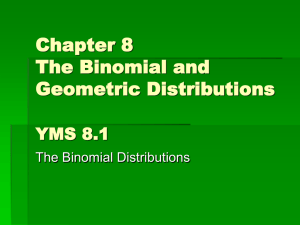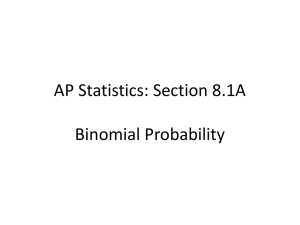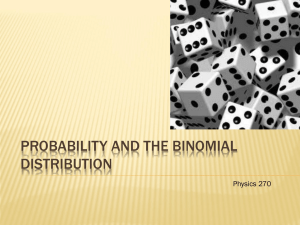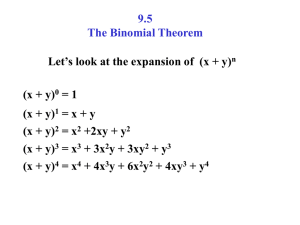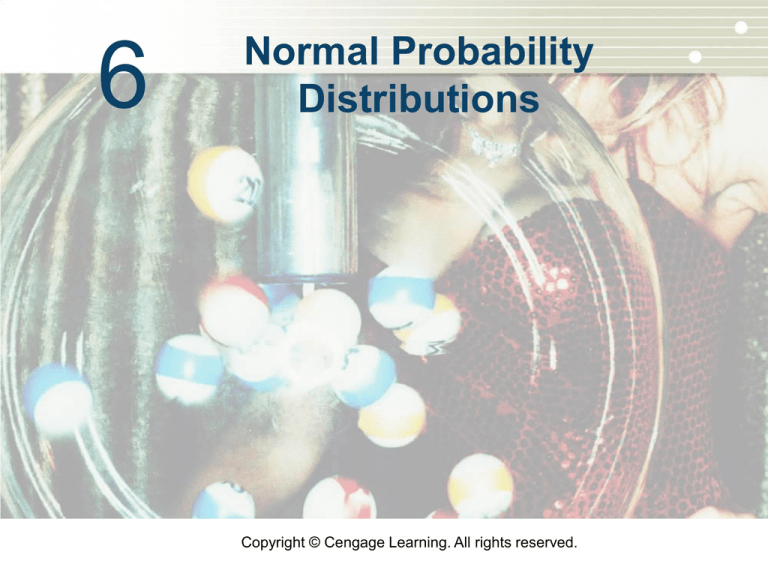
6
Normal Probability
Distributions
Copyright © Cengage Learning. All rights reserved.
6.5
Normal Approximation
of the Binomial
Copyright © Cengage Learning. All rights reserved.
Normal Approximation of the Binomial
We will now see how binomial probabilities—that is,
probabilities associated with a binomial distribution—can
be reasonably approximated by using the normal
probability distribution.
Let’s look first at a few specific binomial distributions.
3
Normal Approximation of the Binomial
Figure 6.12 shows the probabilities of x for 0 to n for three
situations: n = 4, n = 8, and n = 24.
(a) Distribution for n = 4, p = 0.5
(b) Distribution for n = 8, p = 0.5
(c) Distribution for n = 24, p = 0.5
Binomial Distributions
Figure 6.12
4
Normal Approximation of the Binomial
For each of these distributions, the probability of success
for one trial is 0.5.
Notice that as n becomes larger, the distribution appears
more and more like the normal distribution.
To make the desired approximation, we need to take into
account one major difference between the binomial and the
normal probability distribution.
The binomial random variable is discrete, whereas the
normal random variable is continuous.
5
Normal Approximation of the Binomial
We know that the probability assigned to a particular value
of x should be shown on a diagram by means of a
straight-line segment whose length represents the
probability (as in Figure 6.12).
(a) Distribution for n = 4, p = 0.5
(b) Distribution for n = 8, p = 0.5
(c) Distribution for n = 24, p = 0.5
Binomial Distributions
Figure 6.12
6
Normal Approximation of the Binomial
However, we can also use a histogram in which the area of
each bar is equal to the probability of x.
Let’s look at the distribution of the binomial variable x,
when n = 14 and p = 0.5. The probabilities for each x value
can be obtained from Table 2 in Appendix B. This
distribution of x is shown in Figure 6.13.
The Distribution of x When n = 14, p = 0.5
Figure 6.13
7
Normal Approximation of the Binomial
We see the very same distribution in Figure 6.14 in
histogram form.
Histogram for the Distribution of x When n = 14, p = 0.5
Figure 6.14
8
Normal Approximation of the Binomial
Let’s examine P(x = 4) for n = 14 and p = 0.5 to study the
approximation technique.
P(x = 4) is equal to 0.061 (see Table 2 in Appendix B), the
area of the bar (rectangle) above x = 4 in Figure 6.15.
Area of Bar above x = 4 is 0.061, for B(n = 14, p = 0.5)
Figure 6.15
9
Normal Approximation of the Binomial
The area of a rectangle is the product of its width and
height. In this case, the height is 0.061 and the width is 1.0,
so the area is 0.061.
Let’s take a closer look at the width. For x = 4, the bar
starts at 3.5 and ends at 4.5, so we are looking at an area
bounded by x = 3.5 and x = 4.5.
The addition and subtraction of 0.5 to the x value is
commonly called the continuity correction factor.
It is our method of converting a discrete variable into a
continuous variable.
10
Normal Approximation of the Binomial
Now let’s look at the normal distribution related to this
situation.
We will first need a normal distribution with a mean and a
standard deviation equal to those of the binomial
distribution we are discussing.
Formulas (5.7) and (5.8) give us these values:
11
Normal Approximation of the Binomial
The probability that x = 4 is approximated by the area
under the normal curve between x = 3.5 and x = 4.5,
as shown in Figure 6.16.
Probability That x = 4 Is Approximated by Shaded Area
Figure 6.16
12
Normal Approximation of the Binomial
Figure 6.17 shows the entire distribution of the binomial
variable x with a normal distribution of the same mean and
standard deviation superimposed.
Normal Distribution Superimposed over Distribution for Binomial Variable x
Figure 6.17
13
Normal Approximation of the Binomial
Notice that the bars and the interval areas under the curve
cover nearly the same area.
The probability that x is between 3.5 and 4.5 under this
normal curve is found by using formula (6.3), Table 3, and
the methods outlined in Objective 6.4:
14
Normal Approximation of the Binomial
Since the binomial probability of 0.061 and the normal
probability of 0.0594 are reasonably close, the normal
probability distribution seems to be a reasonable
approximation of the binomial distribution.
The normal approximation of the binomial distribution is
also useful for values of p that are not close to 0.5.
15
Normal Approximation of the Binomial
The binomial probability distribution shown in Figure 6.18
suggests that binomial probabilities can be approximated
using the normal distribution.
(a) Distribution for n = 4, p = 0.3
(b) Distribution for n = 8, p = 0.3
(c) Distribution for n = 24, p = 0.3
Binomial Distributions
Figure 6.18
16
Normal Approximation of the Binomial
Notice that as n increases, the binomial distribution begins
to look like the normal distribution.
As the value of p moves away from 0.5, a larger n is
needed in order for the normal approximation to be
reasonable.
The following rule of thumb is generally used as a
guideline:
Rule: The normal distribution provides a reasonable
approximation to a binomial probability distribution
whenever the values of np and n(1 – p) both equal or
exceed 5.
17
Normal Approximation of the Binomial
By now you may be thinking, “So what? I will just use the
binomial table and find the probabilities directly and avoid
all the extra work.”
That doesn’t always work, though. Sometimes you must
solve (and not find) a binomial probability problem with the
normal distribution.
For example, an unnoticed mechanical failure has caused
of a machine shop’s production of 5,000 coil springs to be
defective.
What is the probability that an inspector will find no more
than 3 defective springs in a random sample of 25?
18
Normal Approximation of the Binomial
In this example of a binomial experiment, x is the number
of defectives found in the sample, n = 25, and
p = P(defective) = .
To answer the question using the binomial distribution, we
will need to use the binomial probability function, formula
(5.5):
We must calculate the values for P(0), P(1), P(2), and P(3),
because they do not appear in Table 2.
19
Normal Approximation of the Binomial
This is a very tedious job because of the size of the
exponent.
In situations such as this, we can use the normal
approximation method.
Now let’s find P(x ≤ 3) by using the normal approximation
method. We first need to find the mean and standard
deviation of x using formulas (5.7) and (5.8):
20
Normal Approximation of the Binomial
These values are shown in the figure.
The area of the shaded region (x < 3.5) represents the
probability of x = 0, 1, 2, or 3. Remember that x = 3, the
discrete binomial variable, covers the continuous interval
from 2.5 to 3.5.
21
Normal Approximation of the Binomial
Thus, P(no more than 3 defectives) is approximately 0.02.
22




